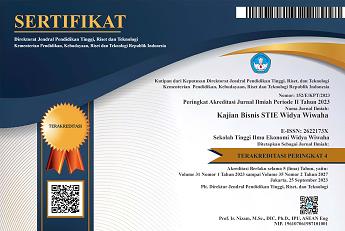KARAKTERISTIK DAN GAYA KEPEMIMPINAN ORGANISASI SEKTOR PUBLIK
DOI:
https://doi.org/10.32477/jkb.v25i1.140Keywords:
Leadership, public sector organization, leadership stylesAbstract
This paper explains the differences in the characteristics of the leadership of the public sector with the private sector. Public sector leadership which emerged as a distinctive leadership and autonomous domain, although the debate continues as compared to business leadership research. This article opens the way for a promising new research on arising of process leadership from the collaboration between business organizations and governance. Leadership training has failed to take into account the operational and the public sector organizational context. This article shows that in the future, the role of ethics and integrity of a leader as well as the importance of emotion and spirituality. A leader who has the ability to see others as people with a variety of emotions, beliefs, skills, knowledge and abilities, and to drive the whole organization towards a clear vision. The impact of different leadership styles are more dependent on contextual factors such as social and cultural environment in which public sector organizations operate.
References
Adair J (1973), Action-Centred Leadership, New York: McGraw-Hill.
Albrecht S (2005), “Leadership climate in the public sector: Feelings matter too!” International Journal of Public Administration 28: 397–416.
Alimo-Metcalfe B and Alban-Metcalfe J (2006), “More (good) leaders for the public sector,” International Journal of Public Sector Management 19(4): 293–315.
Andersen JA (2010), “Public versus private managers: How public and private managers differ in leadership behavior,” Public Administration Review70(1): 131–141.
Bass BM and Avolio BJ (eds) (1994), “Improving Organizational Effectiveness through Transformational Leadership,” Thousand Oaks, CA: Sage.
Burns JM (1978), Leadership, New York: Harper Torchbooks.
Coupland C, Currie G and Boyett I (2008), “New public management and a modernization agenda: Implications for school leadership,” International Journal of Public Administration 31: 1079–1094.
Currie G and Lockett A (2007), “A critique of transformational leadership: Moral, professionaland contingent dimensions of leadership within public services organizations”, Human Relations 60 (2): 341–370.
Dull M (2009), “Results-model reform leadership: Questions of credible commitment,” Journal of Public Administration Research and Theory 19 (2): 255–284.
Fairholm MR (2004), “Different perspectives on the practice of leadership”, Public Administration Review 64(5): 577–590.
Fernandez S, Cho YJ and Perry JL (2010), “Exploring the link between integrated leadershipand public sector performance,” Leadership Quarterly 21(2): 308–323.
Getha-Taylor H, Holmes MH, Jacobson WS, Morse RS and Sowa JE (2011), “Focusing the public leadership lens: Research propositions and questions in the Minnowbrook tradition,” Journal of Public Administration Research and Theory 21(suppl 1): i83–i97.
Hamlin RG, Nassar M and Wahba K (2010), “Behavioural criteria of managerial and leadershipeffectiveness within Egyptian and British public sector hospitals: An empirical casestudy and multicase/ cross nation comparative analysis,” Human Resource Development International 13(1): 45–64, Orazi et al. 499.
Ingraham PW, Joyce PG and Donahue AK (2003), “Government Performance: Why Management Matters,” Baltimore, MD: The Johns Hopkins University Press.
Karmel, Barbara (1978), Leadership: A Challenge to Traditional Research Methods and Assumptions, TheAcademy of Management Review 3.3 (July): 475.
Kim SE and Lee JW (2009), “The impact of management capacity on government innovationin Korea: An empirical study”, International Public Management Journal 12(3): 345–369.
Kunthia R and Suar D (2004), “A scale to assess ethical leadership of Indian private and public sector managers”, Leadership Quarterly 49(1): 13–26.
Lawler J (2008), “Individualization and public sector leadership”, Public Administration 86(1):21–34.
Leslie K and Canwell A (2010), “Leadershipat all levels: Leading public sector organisations in an age of austerity,” European Management Journal 28(4): 297–305.
Lindorff M (2009), “We’re not all happy yet: Attitudes to work, leadership, and high performance work practices among managers in the public sector,” Australian Journal of Public Administration68( 4): 429–445.
McGurk P (2009), “Developing middle leaders in the public services? The realities of managementand leadership development for public managers,” International Journal of PublicSector Management22(6): 464–477.
Morse RS (2010), “Integrative public leadership: Catalyzing collaboration to create publicvalue”, Leadership Quarterly 21(2): 231–245.
Mujtaba BG, Khanfar NM and Khanfar SM (2009), “Leadership tendencies of government employees in Oman: A study of task and relationship based on age and gender,” Public Organization Review 10(2): 173–190.
O’Reilly D and Reed M (2010), “Leaderism: An evolution of managerialism in UK publicservice reform,” Public Administration88( 4): 960–978.
Park SM and Rainey HG (2008),”Leadership and public service motivation in US federalagencies,” International Public Management Journal 11(1): 1–33.
Pfeffer, Jeffrey (1977), “The ambiguity leadership,” The Academy of Management review 2 (1): 104
Rainey HG and Bozeman B (2000), “Comparing public and private organizations: Empiricalresearch and the power of the ‘a priori,” Journal of Public Administration Research andTheory 10 (2): 447–470.
Saz-Carranza A and Ospina SM (2010), “The behavioral dimension of governing interorganizational goal-directed networks: Managing the unity–diversity tension,”Journal of Public Administration Research and Theory 21(2): 327– 365.
Terry L (1995), “Leadership of Public Bureaucracies: The Administrator as Conservator,” Thousand Oaks, CA: Sage Publications.
Trottier T, Van Wart M and Wang XH (2008), “Reinforcing the need for more sophisticationin leadership studies in the government sector,” Public Administration Review68(6):1172–1174.
Van Wart M (2003), “Public-sector leadership theory: An assessment,” Public Administration Review 63(2): 214–228.
Wallis J and McLoughlin L (2007), “A diagnosis of leadership effectiveness in the Irish publicsector,” Public Management 9(3): 327–351.
Yukl GA (1989), “Managerial leadership: A review of theory and research,” Journal of Management 15(2): 251– 289.









